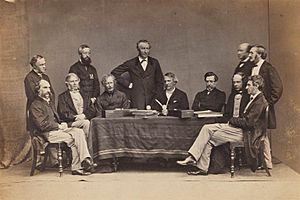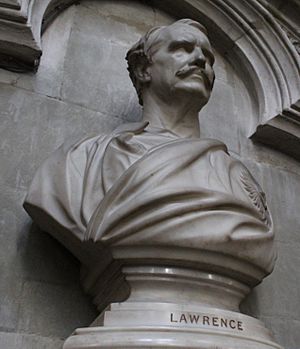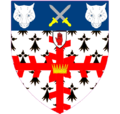John Lawrence, 1st Baron Lawrence facts for kids
Quick facts for kids
The Lord Lawrence
|
|
|---|---|
| Viceroy and Governor-General of India | |
| In office 12 January 1864 – 12 January 1869 |
|
| Monarch | Queen Victoria |
| Prime Minister | |
| Preceded by | Sir William Denison As Acting Viceroy and Governor-General |
| Succeeded by | The Earl of Mayo |
| Lieutenant Governor of Punjab | |
| In office 1 January 1859 – 25 February 1859 |
|
| Governor General | The Earl Canning |
| Preceded by | Office created |
| Succeeded by | Sir Robert Montgomery |
| Chief Commissioner of Punjab | |
| In office 18 January 1853 – 31 December 1858 |
|
| Governor General | The Marquess of Dalhousie The Earl Canning |
| Preceded by | Office created |
| Succeeded by | Office abolished |
| Personal details | |
| Born | 4 March 1811 Richmond, North Riding of Yorkshire, England |
| Died | 27 June 1879 (aged 68) London, United Kingdom |
| Spouses |
Harriette Hamilton
(m. 1841) |
| Alma mater | East India Company College |
John Laird Mair Lawrence, 1st Baron Lawrence (born March 4, 1811 – died June 27, 1879) was an important British statesman. He was born in England but had family roots in Ulster, Ireland. He is best known for serving as the Viceroy of India from 1864 to 1869. The Viceroy was the highest British official in India at that time.
Contents
Early Life and Education
John Lawrence was born in Richmond, North Yorkshire. His family was Protestant and had Ulster-Scots heritage. His mother was from County Donegal and his father from Coleraine in County Londonderry. John spent his early years in Derry, Ireland. He went to Foyle College and Wraxhall School.
His father had been a soldier in India. John wanted to be a soldier too, like his older brothers George and Henry. However, his father thought a career as a civil servant would be better. So, at age sixteen, John joined the East India Company College in Haileybury. He studied there for two years, winning awards in history, economics, and Bengali.
Starting Work in India
In September 1829, John Lawrence joined the Bengal Civil Service. He sailed to India with his brother Henry. In India, he had to pass exams in local languages. He learned Persian and Urdu. His first job was as a magistrate and tax collector in Delhi. Later, he worked in Panipat and Gurgaon district.
In 1837, Lawrence became a settlement officer in Etawah. He got very sick with jungle fever and almost died. He went back to England in 1840 to get better. In 1841, he met and married Harriette Hamilton in Ireland. After traveling in Europe, they returned to India in late 1842.
Back in India, Lawrence became a judge in Delhi and was in charge of Karnal. During the First Anglo-Sikh War (1845-1846), he helped the British army. He made sure they had enough supplies and guns for the Battle of Sobraon.
Working in Punjab
Governing Jullundur
After the First Anglo-Sikh War, John Lawrence was chosen to govern the Jullundur district and Hill-States in Punjab. He made many changes to how things were run. He worked to stop the custom of suttee, where a widow would die on her husband's funeral pyre. He was known for being strict but fair with local leaders.
Board of Administration
After the Second Anglo-Sikh War in 1849, Punjab became a British province. Lawrence was part of a three-person Board of Administration that governed Punjab. His older brother Henry led this board. John helped make many improvements.
He removed taxes on goods moving within Punjab. He also helped create a single currency and postal system. He worked to improve roads and canals. For example, he extended the Grand Trunk Road and built a highway from Lahore to Multan. He also started building the Bari Doab Canal, which helped farmers. John was good with money. He helped increase the government's income by 50% in three years.
John and his brother Henry had different ideas about how to govern. John thought Henry spent too much money trying to keep the support of local nobles. In 1852, both brothers offered to resign. But Lord Dalhousie, the Governor-General, decided to make John the first Chief Commissioner of Punjab. Henry moved to a different role.
Chief Commissioner of Punjab
As Chief Commissioner, Lawrence continued his work. He expanded public works, encouraged industry, and improved education. He gave more power to villages and supported the decisions of village leaders.
In 1856, Lawrence was honored with the title of Knight Commander of the Order of the Bath. This was a special award for his service. He also met his brother Henry for the last time in Calcutta.
The Indian Mutiny of 1857
In May 1857, John Lawrence was in Rawalpindi when he heard about a rebellion by Indian soldiers, called sepoys, in Meerut. This event is known as the Indian Rebellion of 1857.
Punjab had many soldiers, including Europeans and Indian sepoys. Lawrence quickly disarmed sepoys who might rebel. He sent them to the Afghan border. He also sent many Punjabi troops to Delhi, which was a key city in the rebellion. To protect Punjab, he created a special group of European and Punjabi soldiers.
Lawrence asked Sikh leaders for their help. Many Sikh states like Patiala offered soldiers and money to support the British. This helped keep communication lines open between Delhi and Lahore. He also got support from Muslim leaders in Punjab.
As the fighting continued, Lawrence decided to send even more European soldiers from Peshawar to Delhi. Some of his assistants and even the Governor-General, Lord Canning, worried this would leave Peshawar unprotected. But Lawrence believed taking Delhi was more important. His actions helped the British recapture Delhi on September 14. Because of his efforts, he was called the 'Saviour of India'.
After the Rebellion
After the rebellion, Delhi became part of Punjab in February 1858. Lawrence tried to stop acts of revenge against Indians. He asked Lord Canning to allow sepoys who had not rebelled to go home. He also wanted to offer forgiveness to those who had not committed murder and had given up their weapons.
Some people wanted to destroy Delhi and its holy places, like the Jama Masjid. But Lawrence argued that holy places should be saved. He resisted calls for harsh punishments, even though many British people wanted revenge. The rebellion caused many deaths, both among those fighting and from famine and disease afterward.
In 1858, Punjab became a Lieutenant Governorship, which meant more staff and importance. In February 1859, Lawrence left India and sailed back to England. For his service during the mutiny, he received several honors. He was made a baronet, given the GCB, and became a Privy Councillor. He also received a yearly pension. When he arrived in England, he was welcomed with a big ceremony and met Queen Victoria. He also joined the Council of India.
He received honorary degrees from Oxford and Cambridge universities.
Viceroy of India

On January 12, 1864, Lawrence returned to India as the new Viceroy of India. He took over from Lord Elgin. His main goals as Viceroy were to strengthen British power and improve the lives of the Indian people. One of his first actions was to ban the Hindu practice of throwing the dead into the Hooghly River.
Policies in India
Lawrence wanted to make sure farmers had more security and to lower taxes on Indians. He believed that lighter taxes were fair and would help Indians support British rule. He fought against increasing the tax on salt, which would have hurt poorer Indians the most. He thought it was wrong that many British people in India paid no taxes at all. He called them "birds of passage" who only cared about getting rich quickly.
One of the biggest challenges during his time as Viceroy was the Orissa famine of 1866. About one million Indians died in this famine. Some people criticized him for moving the government offices to the cooler hills of Simla, which was far from Calcutta, the main center of power. Lawrence offered to resign, but his resignation was refused.
Foreign Policy
Because of his experience, Lawrence had a lot of freedom in setting India's foreign policy.
In 1863, the leader of Afghanistan died, leading to a civil war. At the same time, the British worried about Russia expanding its power in Central Asia. Lawrence decided on a policy of not interfering in Afghanistan, which was called 'masterly inactivity'. This meant no British officials or soldiers were sent to Afghanistan. He believed that trying to control Afghanistan would lead to another war, like the First Anglo-Afghan War. Some British officers disagreed, thinking that not acting would allow Russia to gain influence in Afghanistan.
Later Life and Legacy
Lawrence finished his five-year term as Viceroy and returned to England in January 1869. In April, he was given the title of Baron Lawrence.
In 1870, he was elected to the London School Board and became its chairman. He left this role in 1873.
In 1878, Lawrence spoke out against the government's policy in Afghanistan, just before the Second Afghan War. He led a group that opposed the policies of Lord Lytton and the Indian government.
John Lawrence died in London on June 27, 1879, at age 68. He was buried at Westminster Abbey. A statue of him was later placed in the Abbey.
Family Life
John Lawrence married Harriette Catherine Hamilton in 1841. They had four sons and six daughters. Some of his children became notable in their own right:
- John Hamilton Lawrence (1845–1913) became the 2nd Baron Lawrence after his father.
- Henry Lawrence (1848–1902) was a famous rugby player who captained the England team.
- Charles Napier Lawrence (1854–1927) became a businessman and was later given the title Baron Lawrence of Kingsgate.
- Sir Herbert Alexander Lawrence (1861–1943) was a general in World War I and a banker.
- Dame Maude Agnes Lawrence (1865–1933) was a civil servant.
Lady Lawrence died in 1917.
Honoring His Memory
Several places and institutions were named after John Lawrence. A boarding house at the East India Company College (now Haileybury and Imperial Service College) and a "house" at Foyle College were named for him. There is also a house named after him at St Paul's School, Darjeeling in India.
Statues of John Lawrence can be found in different places. One statue, originally in Lahore, is now at Foyle and Londonderry College. It used to show him with a pen in one hand and a sword in the other, asking "By which will you be governed?". This showed he was good at both administration and military matters. Another statue stands in Waterloo Place in central London.
Images for kids
See also
 In Spanish: John Laird Mair Lawrence para niños
In Spanish: John Laird Mair Lawrence para niños






